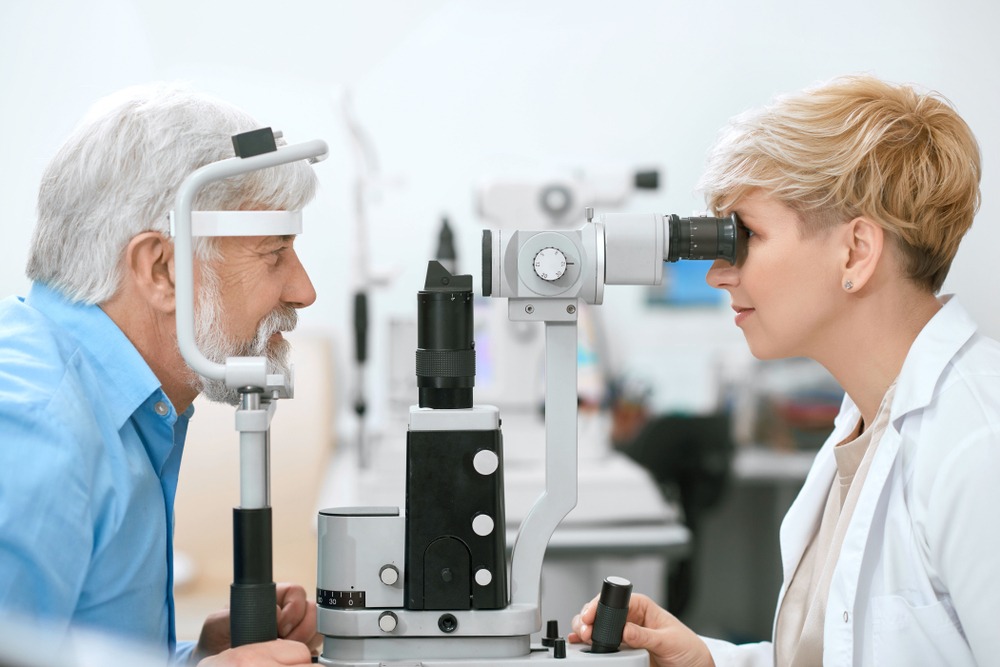Along with the many physical changes that come with growing older, vision changes should perhaps be monitored most closely. Why? Because today, early diagnosis and treatment of eye problems offer the greatest likelihood of retaining sight despite the presence of eye disease. Regular eye exams, competent eye care, and a healthy diet and lifestyle all contribute to maintaining good eye health for seniors, and even preventing some age-related eye problems. The best news? Once you identify and understand the most common causes of vision loss in seniors, it’s easy to make senior eye health a priority.
Common changes in aging eyes.
It’s normal for vision to change as we get older, but good eye care can often mitigate the impact of those changes on daily living. Here’s what many older adults can expect to experience as time goes by. Presbyopia. This is the inability to see close objects clearly or read small print, despite having good distance vision. Presbyopia can begin in one’s 40s. Over time, muscles around the lens of the eye weaken, and the lens itself can harden. In addition to having difficulty reading fine print, without correction, presbyopia can lead to eye strain and headaches. An eye doctor can diagnose and correct presbyopia with reading glasses or bifocals. Floaters. Vitreous is the gel that fills the space between the lens and retina in the eyeball. The shadows of vitreous cast on the retina are seen as floaters, which can appear as spots, threadlike strands, or squiggly lines that drift around, even when the eye stops moving. They are most obvious when looking at something bright, like a blue sky. The sudden appearance of lots of floaters may mean part of the vitreous has pulled away from the retina all at once, sometimes tearing it. One might see light flashes or experience a loss of peripheral vision if the retina lifts from its normal position. This is called retinal detachment. Detached retina. When a layer of tissue at the back of the eye that processes light pulls away from the tissue around it, that’s a serious eye condition. When this happens, the retina can’t work properly, and there could be permanent loss of vision if it isn’t treated immediately. A detached retina doesn’t hurt, and it can happen with no warning. Be aware of such signs as flashes of light, lots of new floaters, or a darkness or “curtain” over the middle or sides of your vision. Dry eyes. This happens when the eyes can’t make enough good-quality tears. The eye may feel a burning sensation, or as if something gritty is in it. Dry eyes are more common in people older than 65, and hormonal changes at menopause can also raise the risk of dry eyes in women. In severe cases, extreme dryness can lead to some loss of vision, but this is rare. Treatments include:
- Using a humidifier at home
- Special eye drops that work like real tears
- Plugging the tear ducts to lessen drainage
- A procedure using heat and pressure called Lipiflow
- Testosterone eyelid cream
- Nutritional supplements with fish oil and omega-3
If the dry eye condition becomes chronic, an eye doctor may prescribe medicated drops to stimulate tear production. Excessive tearing. A sensitivity to light, wind or temperature change may contribute to excessive tearing. It could also signal a more serious problem like an eye infection or a blocked tear duct, but both these conditions are treatable. Eyelid problems. Another perhaps less expected eye-related problem in older adults stems from malfunctioning eyelids. The eyelid protects the eye, spreads tears over its surface, and limits the amount of light that enters. Itching, tearing, and sensitivity to light are common symptoms of eyelid problems. Blinking spasms or inflamed outer edges near the eyelashes are also possible. Treatment can include proper cleaning, medication or surgery.
More serious vision threats after age 60.
Certain conditions may develop that can change one’s vision permanently. They can lead to partial vision loss or blindness. They may have few or no early warning signs. Regular eye exams are your best protection. If an eye care professional finds a problem early, there are often options available to preserve one’s eyesight. With each passing year, be aware of these potential vision disorders, and be vigilant in detecting them. Cataracts are cloudy areas in the eye’s lens causing blurred or hazy vision. Usually, cataracts develop in both eyes, but may be worse in one than the other. Cataracts can cause decreased contrast sensitivity, decreased ability to see in low light (such as when driving at night), dulling of colors, and increased sensitivity to glare. Some cataracts stay small and don’t seriously affect eyesight, whereas others grow large enough to reduce vision. Cataract surgery is a safe, common treatment that uses a clear lens implant to restore good vision. Usually, an eye care professional will watch for changes over time to see whether cataract surgery is warranted. Corneal diseases and conditions cause redness, watery eyes, pain, vision problems, or a halo effect that makes objects appear to have an aura of light around them. Infection and injury are just two common ways the cornea might become damaged. Treatments can range from the relatively simple, like changing one’s eyeglass prescription or using eye drops, to surgery if the case is severe enough. Glaucoma is a group of eye diseases characterized by damage to the optic nerve resulting in loss of peripheral vision. It often affects both eyes, typically one before the other. If left untreated, glaucoma can lead to total blindness. People with a family history of glaucoma, African Americans and older adults have a higher risk of developing the disease. Glaucoma is often painless and can have no obvious symptoms until there is a significant loss of side vision. Diabetic retinopathy is a condition that occurs in people with diabetes. It’s the result of progressive damage to the tiny blood vessels that nourish the retina. These damaged blood vessels leak blood and other fluids that cause retinal tissue to swell and cloud vision. The condition usually affects both eyes. The longer a person has diabetes, the greater the risk of developing diabetic retinopathy. In addition, the instability of a person’s glucose measurements over time can impact the development or severity of the condition. At its most severe, diabetic retinopathy can cause blindness. Age-related macular degeneration (AMD) damages the macula, or central part of the tissue that lines the back of the eye (the retina). This makes certain tasks — reading fine print, seeing vivid color, recognizing faces — much harder. The dry type of AMD affects 9 in 10 people with macular degeneration. It causes more gradual, subtle vision loss from the breakdown of cells in the retina. One may see parts of letters, for example, or straight lines may appear wavy. The wet type of AMD causes distorted vision, with objects appearing as a different size for each eye. There may be a sudden, severe loss of central vision from leaking blood vessels growing in or under the retina. An individual may see a large dark spot in the center area of vision. Anyone having these blind spots should see an eye doctor right away.
Safety, prevention and regular eye exams.
It’s important to remember that what affects overall health can also affect eyesight. As we age, we’re more likely to develop systemic health problems like high blood pressure, heart disease or diabetes. These diseases can seriously damage the eyes. One warning sign of both high blood pressure and diabetes is blurred vision. Always tell an ophthalmologist about such changes as well as which medications and nutritional supplements you take. The doctor will also want to know about eating, sleeping, exercise and other lifestyle choices. What are some of the best ways to lower the risk of serious problems and protect your eyesight as the years go by? Don’t postpone eye exams. Treatable conditions like glaucoma, which damages the optic nerve, and AMD, which creates blind spots, don’t necessarily have warning signs. However, they can be pinpointed early with an examination. If you have diabetes, you’re at risk for diabetic retinopathy — a major cause of blindness. Race and family history also affect risk. Latinos and African Americans are more likely to end up with glaucoma and diabetic retinopathy. Caucasians are a greater risk for AMD. When it comes to cataracts, we’re all at risk. More than half of adults develop the condition by the time they reach age 80. Cataracts are the top cause of blindness worldwide, and though not preventable, they can be corrected with surgery. Eat well to see well. Better eye health starts with diet. A well-balanced diet also helps maintain a healthy weight, which lowers the odds of obesity and related diseases like diabetes. Nutrients like omega-3 fatty acids, lutein, zinc, and vitamins C and E might help ward off age-related vision problems like macular degeneration and cataracts. To get them, eat more:
- Green leafy vegetables like spinach, kale and collards
- Salmon, tuna, and other oily fish
- Eggs, nuts, beans, and other non meat protein sources
- Oranges and other citrus fruits or juices
- Oysters and pork
Please, don’t smoke. Smoking is linked to a higher risk of cataracts, as well as AMD, which strikes twice as many smokers as nonsmokers. Wear sunglasses. Exposure to the sun’s ultraviolet (UV) rays boosts your chances of cataracts and macular degeneration. Wraparound lenses help protect eyes from UV light entering from the side. It’s not a bad idea to wear sunglasses year-round. Take a break from watching screens. They’re everywhere today. Computers, TVs, smartphones. And though too much screen time hasn’t yet been linked to permanent eye damage, hours of screen viewing without a break can result in short-term eyestrain and loss of focus. To keep your vision crisp, experts recommend the 20/20/20 rule: every 20 minutes, focus on something besides your device for 20 seconds, 20 feet into the distance.
A healthy lifestyle awaits at Ventana.
Independent living at Ventana by Buckner offers unmatched luxury for active seniors with discerning taste. Your residency not only ensures all your wellness and medical needs will be met conveniently and with the utmost professionalism, but you’ll also be able to live life on your own terms. No matter what level of care is needed, there will be access to it. Ventana is also a valuable source of information on all topics related to senior living, from protecting your vision with regular eye care to the finer points of medication management. Contact us anytime for information, guidance, or to schedule a personal appointment.

